![]()
.: EXHIBITIONS
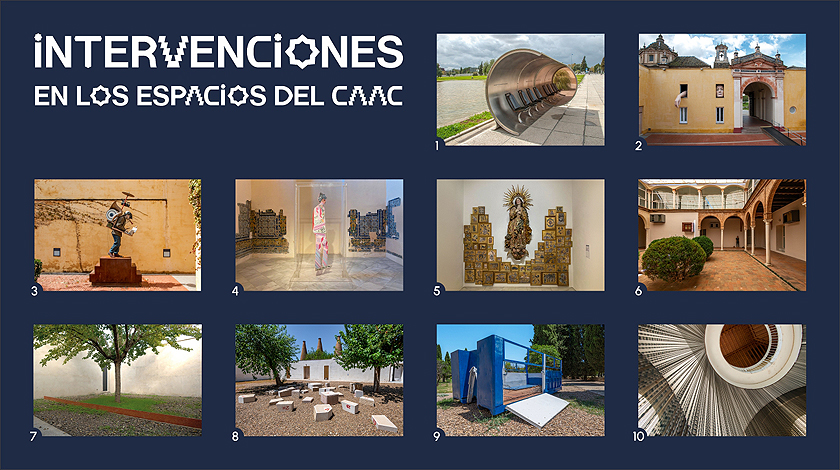

Artists: Ibon Aranberri, Mariajosé Gallardo, Curro González, Carmen Laffón, Cristina Lucas, Priscilla Monge, Pedro Mora, Olaf Nicolai, MP & MP Rosado, Darío Villalba
![]()

PEDRO MORA (Seville, 1961)
Bus Stop, 2001
Installation. Polished stainless
steel, neon and glass. 212 x 359.5 x 210 cm
Piece restored with the support of TUSSAM
GROUND GATE
Pedro de Mora is able to derive sustenance from the societies he inhabits and develop his language around them. His work moves rapidly from one theme to the next, creating an oeuvre that defies classification. However, on this fast-paced journey he never sacrifices the visual component of his ideas, maintaining a clearly defined style.
In Bus Stop, the artist attempts to cross the dividing line between art and the everyday by removing his work from the restricted space of the museum and taking it into the public urban arena. In doing so, he inverts Duchamp’s strategy of bringing objects into the museum that seemingly have no place there. Mora divests the museum of art, reinserting it in a living fabric of ordinary experiences in order to develop a 21st-century aesthetic in the sphere of the civic and the everyday. This work alters the traditional concept of the monument; by using premium materials typically reserved for sculptures, the artist has created a singular prototype of street furniture that can be used as a place of social relaxation or interaction, making users an active part of the sculpture.
![]()
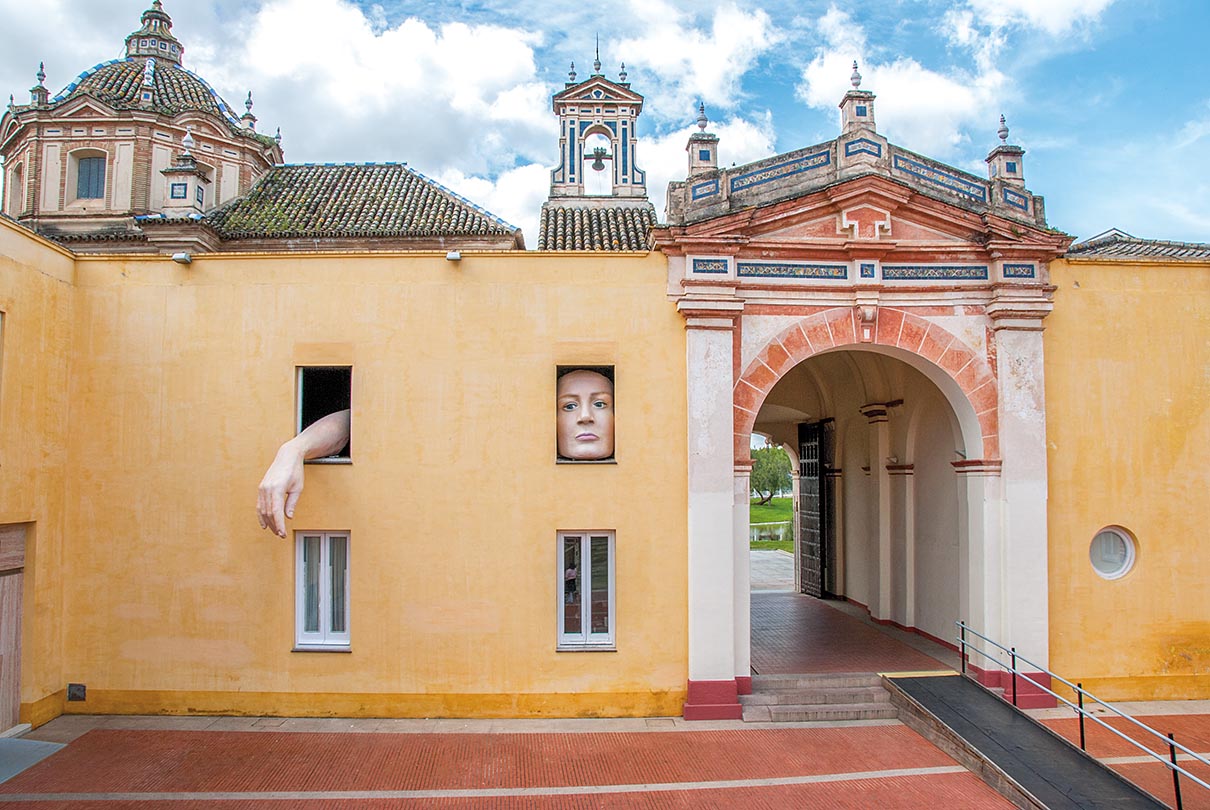
CRISTINA LUCAS (Jaén, 1973)
Alicia, 2009
Installation. Mixed media. Styrofoam
and polychrome fibreglass, 180 x 120 x 85 cm (face)
367 x 120 x 180 cm (arm)
JUANA DE AIZPURU AND CRISTINA LUCAS DONATION
ROYAL PAVILION
Cristina Lucas started out in the field of action art and happenings and later moved on to develop installation art, photography, video, drawing, etc. Focusing on critiques related to gender and cultural and power structures, she uses metaphors and satire to inspire ambiguous feelings in her viewers, always from an apparently innocent feminist point of view.
The installation Alicia presents a gigantic figure whose face and right arm protrude from the open windows of a room in which she seems to have been trapped. The artist’s inspiration for this piece is her reinterpretation of the passage in Lewis Carroll’s famous book Alice in Wonderland where the main character, driven by curiosity, eats a cake with the words “EAT ME” written across it and begins to grow uncontrollably, in this case to the point that she no longer fits in the room and is forced to stick one arm through a window. Cristina’s aim was to bring the book’s unsettling fantasy into the real world and use it as a metaphor for the physical and mental imprisonment of women as a form of oppression, trapped within the confines of their homes. This work was created for the show entitled El patio de mi casa. Arte contemporáneo en 16 patios de Córdoba (2009), for which each participating artist designed an intervention in one of Córdoba’s famous interior courtyards. Cristina Lucas’ piece, presented the typical Córdoba courtyard as a “gilded cage” for women, thereby criticizing this negative aspect of a tradition that dates back to Islamic times.
![]()
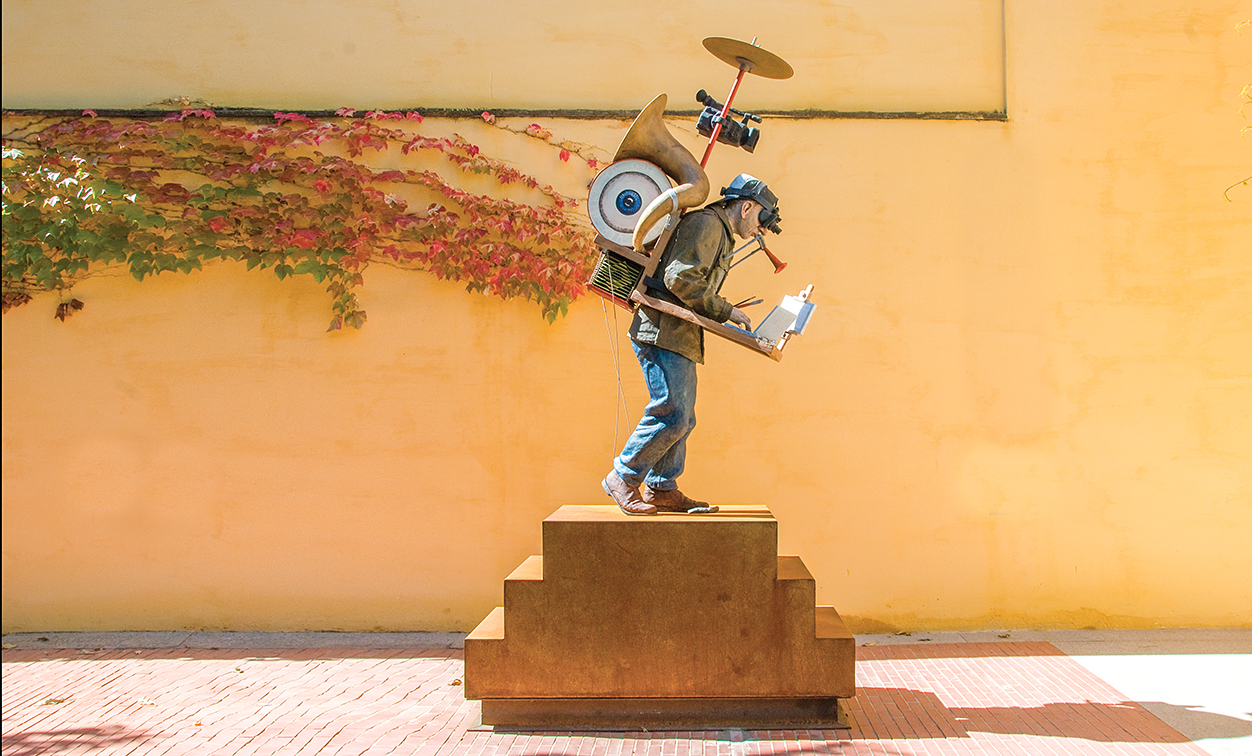
CURRO GONZÁLEZ (Sevilla, 1960)
As a Monument to the Artist, 2010
Polychromed bronze on a weathering
steel pedestal, audiovisual installation (sound, images recorded by a
security camera, monitor),
325 x 100 x 150 cm
JACARANDA WALKWAY
In the guise of a conventional sculptural work and with an ironic commentary on the controversy which has surrounded the notion of the artist since the days of Romanticism, Curro González has come up witht his sculpture installation comprising two elements –audio and visual– that interact with the audience. In this way, he offers a paradoxical version of the individual artist, depicted as the “One- Man Band” who faces the “Gate of Fame”, the threshold which conveys the idea that the ultimate aim of the artist is to achieve a success that will guarantee the preservation of his name and work for posterity.
This initial situation changes when the audience, the ones who actually cross that threshold, is surprised by the sound of a fanfare as they pass through the gate. This constitutes a kind of role reversal game within that chain of recognitions. And that same audience, captured by the camera that resides in the eyes of the artist/one- man band, also catches fleeting glimpses of themselves in another space, beside the main gate or Land Gate, thus becoming part of the artwork for a brief moment and creating a cross of concepts between what the artist sees –the triumphal entry of the spectator- audience– and what the spectator-audience sees in the image projected into another space and context.
![]()

DARIO VILLALBA (San Sebastián, 1939 – Madrid, 2018)
Person 72, 1972
Installation: acrylic paint,
drawing, mould, 230.5 x 135.3 x 120 cm
SAINT BRUNO CHAPEL
The most salient trait of Villalba’s formal style is the use of photography in his plastic research; he uses the cold, alienating photographic backdrop as a painting, as a support surface for the emotions he needs to convey. To this end, he alters them by adding lines, thick strokes of paint and traces of varnish; he breaks them down and modifies the framing; or he veils and unveils the images. His ground-breaking creations were widely acclaimed by the international art world following the presentation of his pink encapsulated figures at the 1970 Venice Biennale.
Villalba’s work is a constant exploration, an investigation of the boundary between photograph and painting and the dividing lines between object, installation and sculpture. And it is an inquiry into every facet of the human being, the true protagonist of his ar. In Persona 72 (Person 72), one of the “encapsulated figures” he revealed to the world in the 1970s, photographic, cut-outs are resurrected as three-dimensional objects that levitate over what might be a gallows or an altam which Villalba associates with the idea on redemption.
![]()
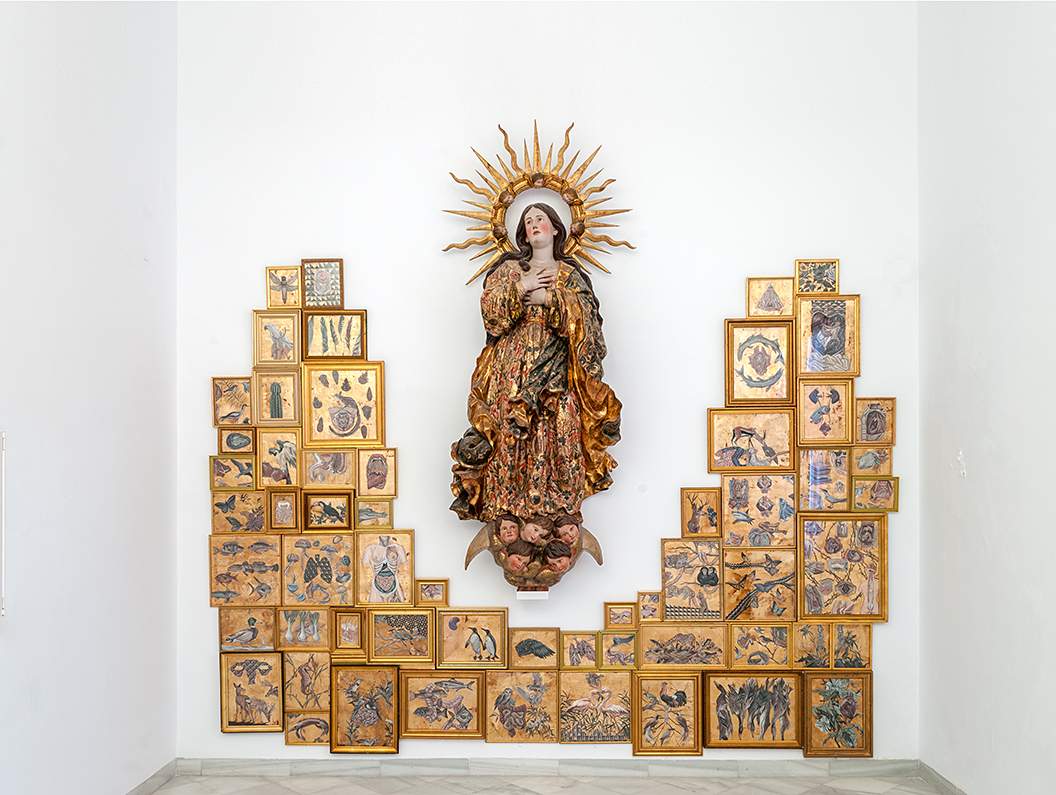
MARIAJOSÉ GALLARDO (Badajoz, 1978)
Ranking de peticiones marianas, 2013
Top Marion Request
Oil and gold leaf on canvas Various sizes
CHAPEL OF SANTA CATALINA
In this artwork exhibited in the Chapel of Santa Catalina, we encounter 59 small- format paintings that together form a half-moon shape around an image of the Immaculate Conception from the early 18th century.
Upon closer inspection of the piece, we discover that each small painting contains a fragment of nature or the human body. Positioned around the religious image like votive offerings in a chapel of devotion, we see these Marian petitions maintaining tradition in color and form but not in pictorial language..
![]()

MP & MP ROSADO (San Fernando, Cádiz, 1971)
Intimacy, 2002
Terracotta, pigments and wax
Illuminated Windows,
2005
Wood, paint and electrical installation
PRIORY COURTYARD
For Miguel Pablo and Manuel Pedro Rosado Garcés, the creators of these two works that function as a single installation, their status as twins has positively influenced much of their work. The theme of identity is of paramount importance in their production, giving it a profound psychological and philosophical depth. Therefore, their sculptures, like this one leaning against the wall titled Intimacy, are often self-portraits, but... of whom? This mirror-like play intensifies upon discovering that the two human masks (there is a third of a beast or wolf) match the features of the character. The word “person” has its origin in classical Greek, It meant “actor’s mask.” So perhaps we are all actors playing our roles behind a mask. Intimacy would thus be what happens and we conceal behind the face.
Similarly, in Illuminated Windows, these artists confront us with the mystery of the human condition. The Argentine writer Roberto Arlt wondered in the middle of the night who was behind the lights of the buildings. What might their inhabitants be like? What do they do? What are they doing now that I see their trace of light?... It is, once again, the great issue of otherness, which is defined in our dictionary as “the condition of being other.” Indeed, art makes us think and question things, which is the basic principle of Philosophy.
![]()
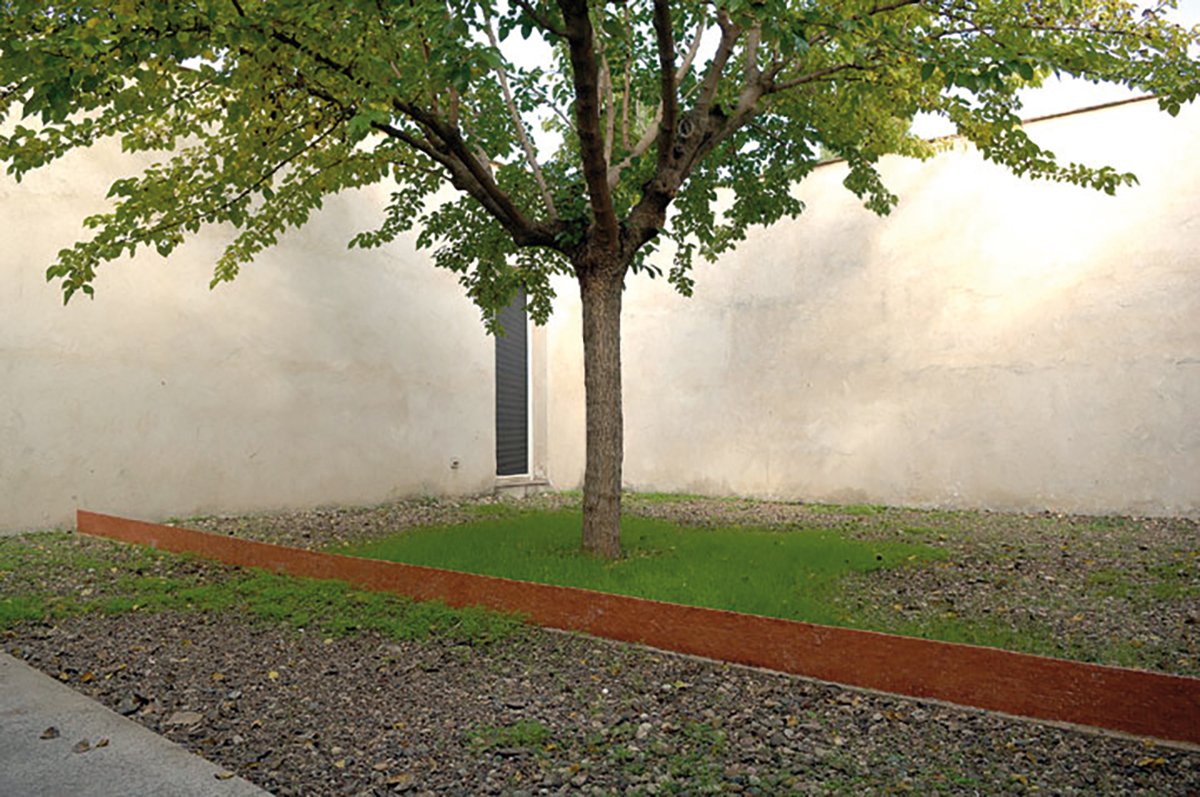
PRISCILLA MONGE (Costa Rica, 1968)
What is Real?, 2004
Installation. Ceramic bricks
30 x 800 cm (3.2 x 2 cm each brick)
NORTH CLOISTER
Priscilla Monge created this piece for the 1st Contemporary Art Biennial of Seville and designed it specifically for the place where it stands today, one of the orchards tended by the monks who once lived in the Carthusian Monastery.
What Is Real? is a small wall made of miniature ceramic bricks, assembled with painstaking care and running straight across the orchard. The author deliberately placed the wall opposite a mulberry tree standing in the middle of the courtyard in order to create a disconcerting contrast of scales.
![]()
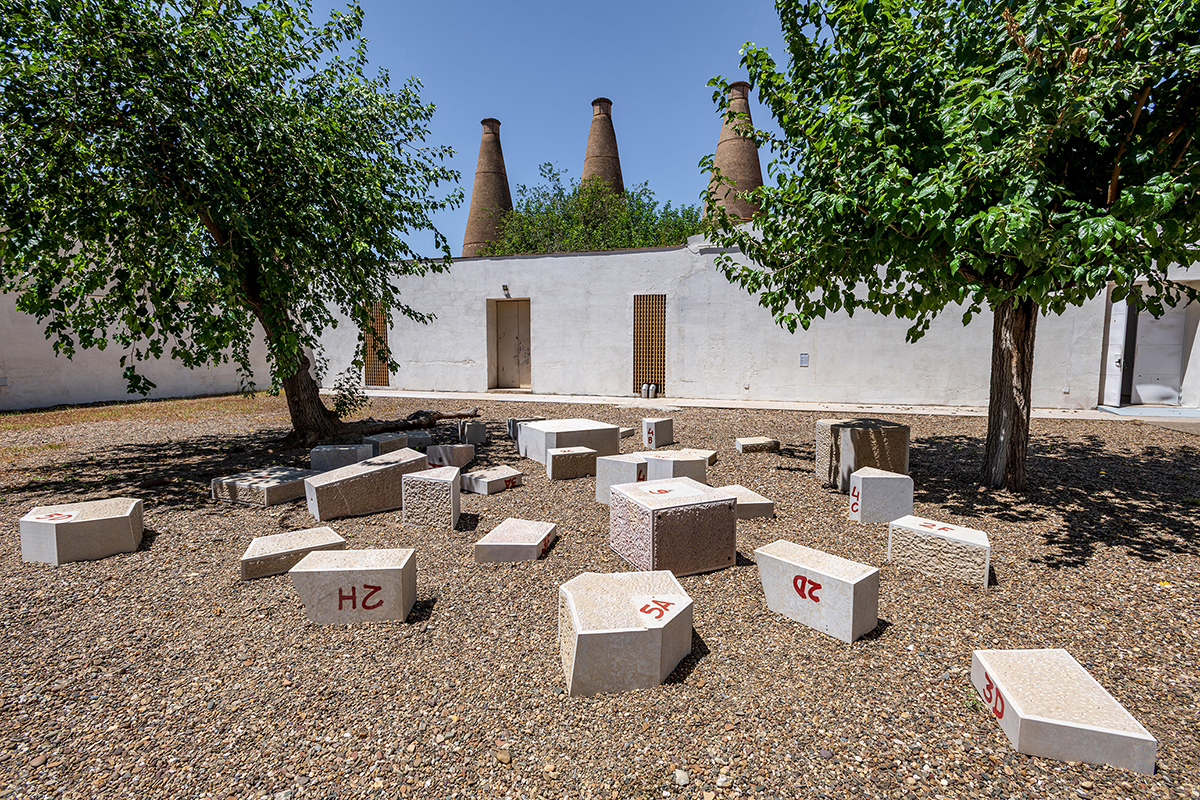
IBON ARANBERRI (Deva, Guipúzcoa, 1969)
Found Dead, 2007-2011
Carved blocks of sandstone and
hollow replicas of MDF
Variable dimensions
GARDEN 7
Found Dead comes forth as an extension of the work that under multiple formats and media the artist Ibon Aranberri has developed in the last years. Unlike other episodes of his trajectory in which the exhibition space evoked an archival space, here the exercise of the exhibition adopts its own archetype, configuring itself as an object, an autonomous construction which goes back to the formalism of sculpture.
In this case, the sculptural is condensed in an opaque entity; the origins that have inspired it are annulled in a formal simulation with the resonance of its own academic definition. This way, the piece stages the irreversibility between the symbolic-communicative functionality of classical sculpture and the auto-referential hermetecism of abstract sculpture, paradigmatic of modern tradition. Found Dead is a dead form, a negation of the narrative possibility.
Delimiting referentiality to a domestic context is a common attitude in Ibon Aranberri´s work. Here, the result is a consequence of a collateral effect, of an unforeseen encounter, of an in- situ approximation within the mechanics of a “field work” focused elsewhere. A repeated monolith appears on several occasions like an accident found along the road.
![]()
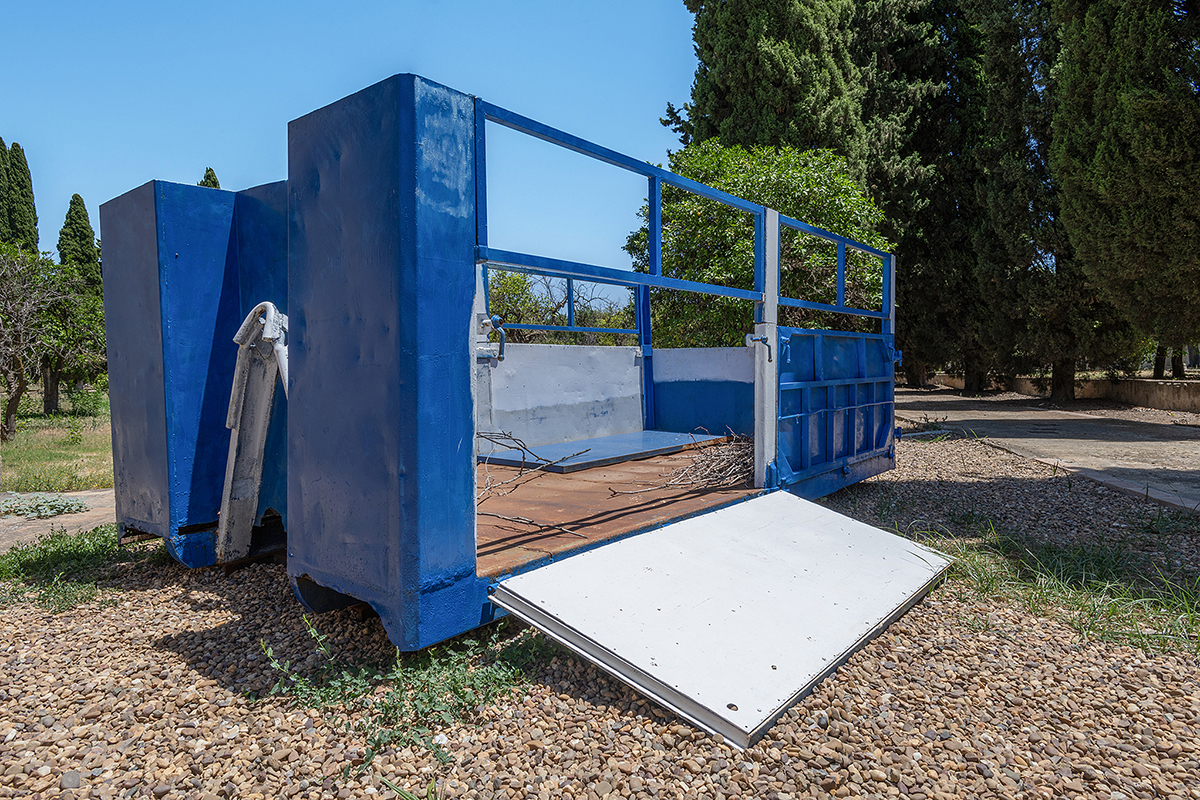
CARMEN LAFFÓN (Seville, 1934-2021)
The Tub, 2011
Installation. Iron, bronze, paint,
and natural elements. 150 x 500 x 250 cm
GARDENS
This installation is a very interesting testimony of Carmen Laffón’s production, a leading figure in Spanish painting of our time. Her painting and drawing had a unique style, capable of creating subtle and evanescent atmospheres. With them, she built a very personal lyrical vision of reality. Due to the physical consistency of sculpture art itself, such “dematerialization” was incompatible with the medium. However, it is precisely in sculpture where we can best appreciate, distilled, without the suggestion of that delicacy of strokes and textures previously pointed out, her artistic spirit. In sculpture and in this installation we can appreciate the love for the things that surrounded her, that is, her plastic and poetic universe. For her, Sanlúcar de Barrameda (Cádiz), its natural and cultural landscape, was a kind of paradise on earth, her “place in the world.” This tub, full of vine shoots, some of bronze and others natural, is good evidence of this, where the natural and its human interpretation or elaboration merge, as mentioned before.
On the other hand, Laffón created pictorial series based on the banks of the Cartuja for her landscapes of Seville and the Guadalquivir (the same river that dies in Sanlúcar). The ancient Carthusian monks cultivated the vine; for wine was a fundamental element in their vegetarian diet, a drink that is at the same time an essential element in Catholic religion and culture. For all these reasons, this piece presented here acquires added value.
![]()
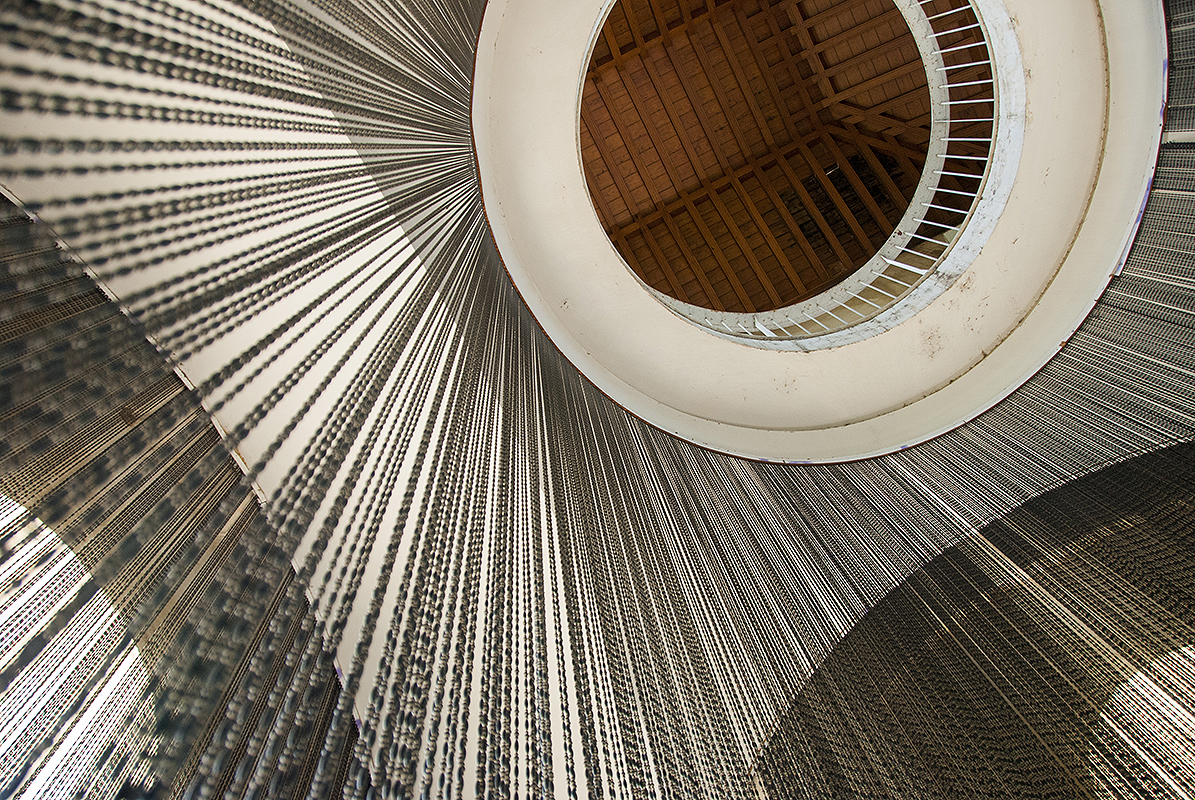
OLAF NICOLAI (Halle/Saale, Germany, 1962)
Black Pearl Curtain, 2004
Installation. Black plastic pearls,
cotton string Dimensions variable
PAVILION OF SAINTS JUSTA AND RUFINA
Since 1997, the artist Olaf Nicolai has developed a wide variety of interdisciplinary projects. The boundaries between art and science, public and private space, or individual and society are the connective thread of his oeuvre, present in one way or another in every phase of his already impressive career..
Black Pearl Curtain was produced for the 1st Contemporary Art Biennial of Seville, and the artist himself chose to install it in the Pavilion of Saints Justa and Rufina, also known as the Pickman Pavilion. This building has an open-sided ground floor, large windows on the second storey and a lookout tower at the top.
Nicolai’s work covered all of those openings with curtains of black plastic beads, creating a prop that divides the space and subtly conditions both physical and visual access. These curtains situate us on the borderline between public and private, between inclusion and exclusion, which is characteristic not only of Seville’s architectural situation but also of its geopolitical context.
